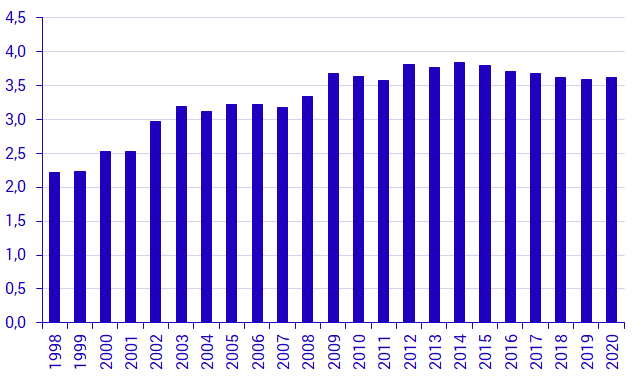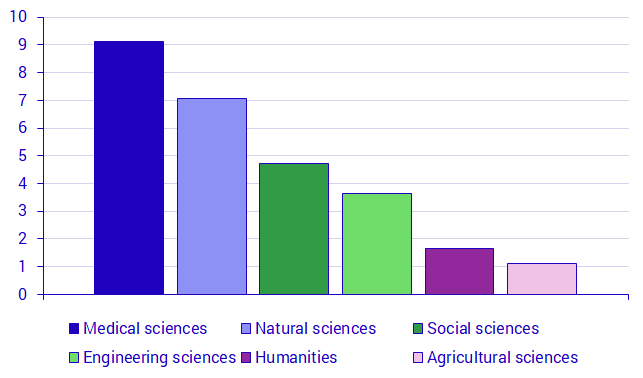Government budget allocations for R&D (GBARD) 2020
Increased funds for R&D in several expenditure areas in 2020
Statistical news from Statistics Sweden 2020-04-15 9.30
In 2020, funds for research and development (R&D) in the central government budget are estimated at SEK 38.5 billion. This corresponds to 3.6 percent of total appropriations in the central government budget. Government funding for R&D is expected to increase by SEK 1.1 billion compared with the forecast for 2019, at the price level of 2020. This forecast is based on the provisional budget for 2020.
According to Statistics Sweden’s statistics, government funding to R&D is expected to increase by SEK 1.1 billion in 2020 compared with the forecast of 2019. Relative to the total appropriations in the central government budget, the share of R&D funding in the state budget has remained largely unchanged since 2018. The central government budget is grouped into 27 expenditure areas. The main expenditure areas in the state budget that are responsible for the increase are Education and academic research and General environmental protection and nature conservation. As in previous years, Education and academic research account for the largest increase, in which R&D funding increased by approximately SEK 865 million.

Most funding for the general advancement of knowledge in medical and health sciences
R&D funding is grouped by the objectives of the R&D. General advancement of knowledge is the single largest objective and accounts for 71 percent of R&D funding in the central government budget. This objective is expected to increase by over SEK 768 million compared with the forecast for 2019, and is also the objective that has increased the most compared to 2019. Universities, institutions of higher education and the Swedish Research Council are the main recipients of funding for this purpose. General advancement of knowledge is divided into six research areas, in accordance with the nomenclature for the analysis and comparison of scientific programmes and budgets (NABS). Under this classification, the area of medical sciences accounts for 24 percent of the R&D appropriations, which is the largest share. Improvement in defence is the objective that decreased most, by an estimated reduction of SEK 86 million compared to 2019.

Facts
The forecast is based on the provisional budget of 2020.
The “Government budget allocations for R&D” survey, on which these statistics are based, highlights how much of the central government budget is used to fund R&D. Unlike regular surveys on R&D activities in various sectors of society carried out every two years, this survey provides an up-to-date forecast of central government appropriations for R&D.
The survey follows guidelines prepared by the OECD and published in the Frascati Manual – Guidelines for Collecting and Reporting Data on Research and Experimental Development (OECD, 2015). These statistics are also subject to Commission Implementing Regulation (EU) No 995/2012.
The survey results also include a forecast of R&D disbursements by public research foundations. These funds are presented separately and are not included in the report on total R&D funds in the central government budget.
Fixed price calculation
This statistical news includes comparisons over time concerning government funding to R&D. All comparisons are based on fixed-price calculated price levels for 2020. Fixed price calculation is an approach used to restate (adjust for inflation) price levels and to clear any price effects that may impact expenditure levels. Fixed price calculation applies GDP deflators according to:
Deflator = (Nominal GDP)/(Real GDP)×100
Definitions and explanations
Research and experimental development (R&D) comprise creative and systematic work undertaken in order to increase the stock of knowledge – including knowledge of humankind, culture and society – and to devise new applications of available knowledge.
For an activity to be an R&D activity, it must satisfy five core criteria. The activity must be:
- Novel
- Creative
- Uncertain
- Systematic
- Transferable and/or reproducible
Facts
The forecast is based on the provisional budget of 2019.
The “Government budget allocations for R&D” survey, on which these statistics are based, highlights how much of the central government budget is used to fund R&D. Unlike regular surveys on R&D activities in various sectors of society carried out every two years, this survey provides an up-to-date forecast of central government appropriations for R&D.
The survey follows guidelines prepared by the OECD and published in the Frascati Manual – Guidelines for Collecting and Reporting Data on Research and Experimental Development (OECD, 2015). These statistics are also subject to Commission Implementing Regulation (EU) No 995/2012.
The survey results also include a forecast of R&D disbursements by public research foundations. These funds are presented separately and are not included in the report on total R&D funds in the central government budget.
Next publishing will be
The next statistical news in this series will be published in April 2021.
Feel free to use the facts from this statistical news but remember to state Source: Statistics Sweden.
